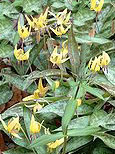 One of the most endearing wild flowers is the dogtooth violet also called trout lily. The yellow nodding flower with its recurved petals and long brown stamens is borne singly on a leafless scape above 3-6 soft green marbled leaves. Wheather it is the leaves or the flower that captivates my heart, I don’t know, but it is one of my fondest memories from childhood when my playground was the wooded lot next door. As a child, I learned the name ‘dogtooth violet’ but am trying to switch to ‘trout lily’ now because the plant is certainly not a violet and IS a lily. The dogtooth violet name came into being because of the tooth-like shape of the bulb (actually a corm); trout lily describes the resemblance of the leaves to the side of a brook trout. No matter what you call it, the plant is a joy to find in early spring, usually growing in large colonies where the leaves from the trees above make a rich, humus soil. An excellent plant for both woodland and rock gardens.
One of the most endearing wild flowers is the dogtooth violet also called trout lily. The yellow nodding flower with its recurved petals and long brown stamens is borne singly on a leafless scape above 3-6 soft green marbled leaves. Wheather it is the leaves or the flower that captivates my heart, I don’t know, but it is one of my fondest memories from childhood when my playground was the wooded lot next door. As a child, I learned the name ‘dogtooth violet’ but am trying to switch to ‘trout lily’ now because the plant is certainly not a violet and IS a lily. The dogtooth violet name came into being because of the tooth-like shape of the bulb (actually a corm); trout lily describes the resemblance of the leaves to the side of a brook trout. No matter what you call it, the plant is a joy to find in early spring, usually growing in large colonies where the leaves from the trees above make a rich, humus soil. An excellent plant for both woodland and rock gardens.
Type: Bulb.
Bloom: Yellow nodding flowers up to 2” wide in late winter to early spring.
Size: 4-10” H; may form large colonies.
Light: Part shade; plant under deciduous tress for maximum light in spring followed by cool shade in summer.
Soil: Moist, rich acidic (pH6.8).
Hardiness: Zones 3-9.
Pests and Diseases: Slugs can be a problem.
Propagation: Divide offsets in late summer to fall and plant 3-5” deep; collect mature seeds 6-8 weeks after flowering and plant ASAP because seeds lose viability as they age. (Plants grown from seed may take years to flower.)
Companion plants: Spring Beauty (Claytonia virginica), crocuses, grape hyacinths (Muscari spp.)
Comment: Native to the eastern half of the U.S.; dies down and disappears after blooming.

We went on a hike in WV last spring and saw them all over the place. It was the first time I ever noticed them and they are lovely. They were almost side-by-side with a dainty white flower. I can’t wait to see them again this spring.
Just checked out your companion plants and the white flower was the Claytonia virginica. It pays to read the whole article!
I have always been extremely fond of spring ephemerals since my days in Poughkeepsie where I had lots of woodland to explore and even saw colonies of lady slipper orchids. Great woodlands there! I also remember well the trillium, rue anemone, Dutchman’s breeches, bluets, bloodroot, mayapples, and hepaticas. I feel inspired.
Karen